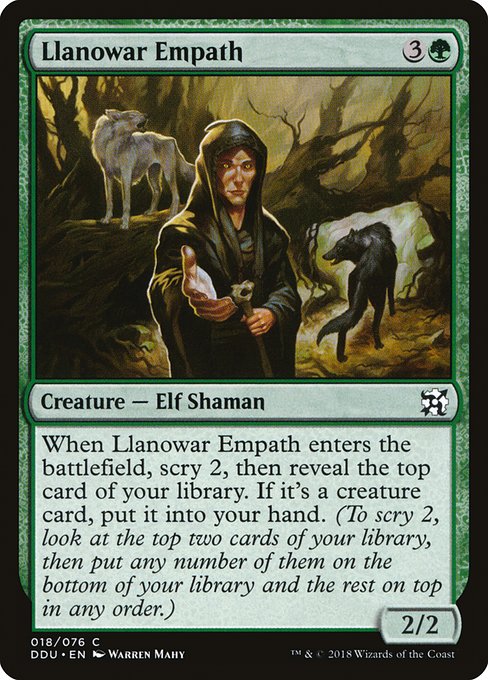
Image courtesy of Scryfall.com
Speculation, value cycles, and the green spark: Llanowar Empath in MTG finance
MTG finance is as much about culture as it is about numbers 🧙♂️🔥. The community watches sets, reprints, and rotation with the same excitement you feel opening a rare pack—only this time your curiosity spills into price charts, market memory, and the ethics of how we acquire our collection. Within this landscape, Llanowar Empath stands out as a small but telling lens on speculation. A common green creature with a thoughtfully simple ability, its value isn’t just in dollars and cents; it’s in how it teaches players to think about forethought, risk, and the human rhythms of play.
Printed in Duel Decks: Elves vs. Inventors and illustrated by Warren Mahy, Llanowar Empath is a 4-mana (3 generic and 1 green) 2/2 Elf Shaman. Its true gear shift isn’t a flashy battle cry, but a clean, proactive engine: when it enters the battlefield, you scry 2, then reveal the top card of your library. If that revealed card is a creature, you put it into your hand. The cycle is elegant in its restraint—green’s core strengths, plus a built-in stream of card selection. It’s a card that rewards thoughtful deck-building and careful metagame reading, which is precisely the mindset that drives responsible speculation. The card’s rarity—common—speaks to accessibility, but the real influence comes from how it interacts with top-deck manipulation and creature density in your curve 🎲💎.
What Llanowar Empath teaches about foresight
In a world where a single reprint can swing prices and alter how players crave a budget-friendly playset, Empath’s utility is a reminder that foresight matters. The scry 2 on ETB (enter the battlefield) sets up a two-step decision: first, peek ahead to shape what you’ll draw next; second, if your top card is a creature, you gain a seamless replacement for that card in hand. The odds and the payoff are a tiny lesson in risk-reward: you sometimes tilt toward immediate card advantage, sometimes you don’t draw a creature, and sometimes you simply trim the top of your library to the precise shape your deck needs. It’s a tiny mirror for how speculators evaluate probability curves, volatility, and the time horizon of a given purchase 🔮⚔️.
From a collector’s perspective, Empath’s status as a common reprint in a 2018 Duel Decks set gives it a steady baseline. The prices listed on market trackers are modest, which makes it approachable for casual players, EDH enthusiasts, and budget monitors alike. The card’s evergreen green identity and the steady demand for green tempo tools keep it relevant long after the initial hype fades. That stability matters when discussing ethics: it means you’re less likely to see extreme arbitrage spikes that squeeze new players out of access to playable cards in a format or deck archetype. When a card remains affordable, the community at large is more likely to stay engaged 🎨💎.
Ethics in speculation: practical guardrails
Speculation can be a force for good—encouraging collectors to study archetypes, understand openings, and plan long-term. It can also be a minefield where predatory pricing and sudden supply constraints hurt players who aren’t already in the know. The Llanowar Empath example invites five guiding thoughts:
- Transparency over hype: track why a price moves—is it a deck trend, a new combo, or a limited reprint that restored supply?
- Long horizons over quick flips: consider whether you’re buying for play or for investment, and be honest about your exit plan.
- Fair access for players: avoid tactics that push prices beyond a casual player’s reach; support stores and communities that keep stock accessible.
- Diversification of portfolios: don’t pile into a single card; spread risk across a spectrum of staples and variables.
- Ethical sourcing and sharing knowledge: use price data to educate others, not to pressure a friend into paying more for a card they want to play with tonight.
In practice, that means if you’re eyeing Llanowar Empath as part of a green ramp strategy or a budget-friendly EDH inclusion, you’re not just buying a card—you’re investing in a tiny ecosystem: a creature that helps you fetch the right answers at the right moment, a community that appreciates accessibility, and a marketplace that should reward patience as much as speed 🧙♂️🔥.
Guidance for thoughtful collectors and players
Here are some tactics that keep speculation healthy and fun:
- Set a planned budget and a time window. If Empath fits your green shell and you believe it will see continued play, consider a modest accumulation over several months rather than a single, all-in purchase.
- Anchor your decisions in play experience. Cards like Llanowar Empath thrive when you can justify their value by actual deck performance rather than solely by price charts.
- Balance “playability value” with “collectible value.” A common card with reliable utility often ages gracefully, even as the meta shifts.
- Support your local game stores and community groups. A healthy local scene stabilizes availability and keeps prices fair for new players stepping into modern, commander, or other formats.
- Document your rationale. Keeping notes on why you acquired a card helps maintain discipline when prices swing and prevents impulsive, emotion-driven buys.
As with any foray into MTG finance, the goal is balanced enthusiasm 🧙♂️🎲. Llanowar Empath embodies that balance: a green tempo tool that’s accessible, a mechanism that nudges you toward better deck decisions, and a reminder that even a small card can teach big lessons about foresight and fairness in a vibrant, ever-shifting hobby.
Neon Gaming Mouse Pad 9x7 Custom Neoprene Stitched EdgesMore from our network
- https://transparent-paper.shop/blog/post/billion-star-catalog-tale-through-a-sagitta-blue-giant/
- https://transparent-paper.shop/blog/post/designing-modern-portfolio-templates-that-designers-love/
- https://blog.digital-vault.xyz/blog/post/understanding-variability-in-a-distant-blue-giants-light-curve/
- https://blog.digital-vault.xyz/blog/post/stoic-farmer-flavor-text-uncovering-character-references/
- https://blog.digital-vault.xyz/blog/post/balancing-randomness-and-player-control-in-isolation-at-orthanc/